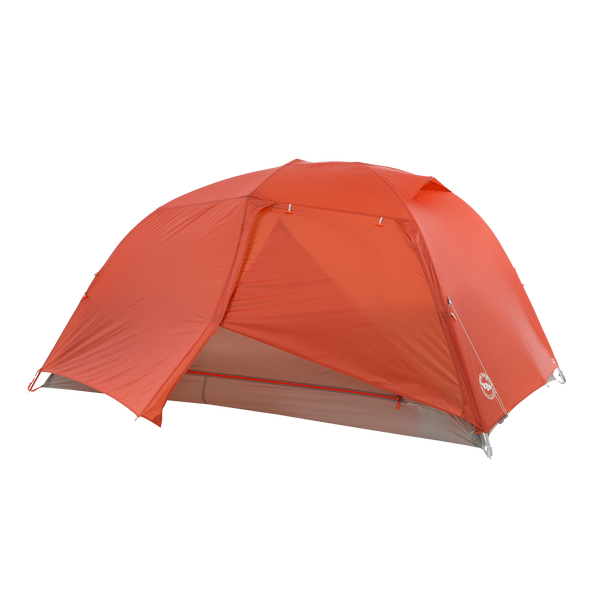Everything on your tent has a purpose.
Every loop and clip and centimeter of fabric has been agonized over and tweaked to make your tent the best it can be. Taking advantage of all the features of your tent can elevate your great shelter into a phenomenal backcountry home.
Setting Up Your Tent Like A Pro
There is no one right way to set up your tent. But when the weather could get nasty, there is a wiser way to set it up. A tent that takes a tumble or a fly that takes off is not covered under our warranty, so be sure that you're setting up your tent prudently!
Start by choosing an area that is flat, (relatively) free from debris, and away from potential hazards like overhanging dead trees/branches. Look for areas that are relatively protected from the elements - pitching next to large rocks, canyon walls, or under healthy, sturdy trees can help you have a more peaceful night's rest.
While it may be tempting to pitch next to a stream or river, ensure that your tent is elevated enough to avoid any rising water or flash floods. Even if you're not expecting rain where you are, storms many miles upriver can cause swelling water levels. Similarly, ensure that your site allows water to escape from under your tent, avoiding areas where water may pool during storms.
Try staking your footprint to the ground first, then your tent body, before you clip them into the poles. Then clip your fly onto one corner of your tent body before you throw it over the top of your tent poles. This will prevent your tent from turning into a kite.
Pro Tip: If you are in a windy area, do your best to orient your tent so that the foot (shorter side) faces into the prevailing wind. This will put your tent in the best position to resist even strong winds, and reduce flapping noises during the night.
Using Your Guylines Efficiently
It is crucial to utilize your guylines every time you pitch your tent. Your guylines work in conjunction with your poles to maintain the structural integrity of your tent. It may not seem windy when you set up camp, but you never know what the weather may do during the night, or while you're out adventuring. Guylines are most effective when staked directly into the prevailing wind. Often times you can attach guylines to the stakes you used on the tent body. You can also attach multiple guy lines to a single stake.
Pro Tip: If you're expecting high winds and extreme weather, bring extra tent stakes and stake out each guyline to its own stake, as far away from your tent as possible.
Staking Your Tent
We have seen all kinds of camping calamities. But the worst we've ever seen is a hook stake embedded deep in the arch of our friend Dart Man's foot. Stakes will go through a flip flop or a shoe, so take a minute and find a rock to use if you don't have a hammer. The ideal way to anchor a stake into the ground is at a 45 degree angle, with the bottom of the stake angled in towards your tent and the top angled away, creating a 90 degree angle with any attached guy lines. Hammer your stake all the way into the ground so it doesn't bend or uproot in the middle of the night.
Pro Tip: Big Agnes Dirt Dagger UL stakes allow for minimal carry weight and maximum effect when used correctly. They are designed to be used with the wider, notched side facing out, away from your tent.
Taking Down Your Tent
When you are packing up it is easy to leave things behind. Start by collapsing your tent completely before you unstake it. This means removing the fly, unclipping the tent body from the poles and putting away the fly and poleset in the carrying sack. There will be just your tent body, footprint and stakes laying flat on the ground. Make sure you empty out the inside of your tent body and always store your gear clean, dry and free of debris. Do a lap around your tent collecting all your stakes, then fold up your tent body and footprint. Do a stake count. Have them all? Happy Trails!
Using a Footprint
Do you really need a footprint? Yes, but not for the reasons you think. Using a tent without a footprint is like riding a bike without a helmet: you might get away with it most of the time, but when you need it, you really need it. Your tent's footprint is made of durable material, which acts as a buffer keeping everything scratchy from puncturing the floor of your tent. Your footprint is also a really cool piece of gear to have for non-tent use. Want to cowboy camp? Throw down your footprint underneath your pads. Mid-day lunch break? Keep the ants out of your pants by sitting on the footprint. Waiting out a hail storm? Throw your footprint up as a multipurpose weather shelter. Muddy dogs need a ride home? Line the back seat of your car with your footprint.
Fast Fly Your Tent
Why fast fly your tent? Because sometimes you need a fast shelter from the weather, or want to take a mid-day nap, or to increase tent ventilation. To set up your fast fly option you need stakes, a footprint, tent fly and your poleset. Clip your fly and poleset directly into your staked out footprint. Guy out your fly and you are ready to go. This is also a great shelter option for superhero dogs that like jumping through mesh doors- finally a tent that they have the freedom to enter and exit as they please.
Ventilating Your Tent
Ventilation is KEY. Seriously. No matter the location, no matter the weather, being able to vent your tent even the slightest bit can help keep you dry. A majority of Big Agnes tents come with vent windows which we strongly encourage using. Even just a small bit of circulated air can help prevent condensation buildup. If weather and the tent allow for it, opening your rain fly door can help as well. Be sure to have your tent staked out properly and utilize all guy lines to prevent the rain fly from laying against your tent body. Keep a healthy distance between your rain fly and tent body for maximum ventilation.
Pro Tip: Many of our tents feature a "low vent" mode, designed to increase ventilation without sacrificing coverage. Ever wonder what the extra toggle on the inside of your rainfly near the top of the door is for? Attach the stake loop on the end of your tent's door to it, and zip down until taught - you're now in low vent mode!

Even with your best effort to vent your tent, condensation will occur. Think of the dew or frost on your car in the morning. There is water vapor in the air everywhere on earth. At night the air cools and that vapor settles as condensation on everything. Adding to the natural condensation that occurs when sleeping outside is water vapor radiating off your wet gear and up to a liter per night of water coming off your body in the form of sweat and exhalation. Minimize the inevitable camping condensation by getting a nice taut pitch on your tent and leaving it as open to cross ventilation as possible.
Using Your Tent in the Rain
We love camping in the rain. Is there any better sound to fall asleep to? Your tent will get wet from natural condensation before you add rain into the mix. When it's raining, condensation buildup is exacerbated by the water coming down on your tent. Condensation inside your tent will bead and drip down on you when pounded by the force of rain falling on your fly. Isn't that fun, a rain storm outside your tent can make a mini rainstorm inside your tent! Your inner science geek may find observing weather patterns on a micro level to be incredibly cool, but the part of you that likes sleeping dry and warm may not be as amused.
To mitigate condensation buildup when it's raining, make sure your tent is staked out taut, without any wrinkles or loose sections, and all guylines are utilized. Guylines will help pull the rain fly tight and keep it from touching the tent body. Using your guylines will also help shed water and prevent pooling on your fly.
It is normal for your tent fly to get saggy during a rain storm. The nylon we use for our tents is incredibly dynamic fabric that is treated with waterproof polyurethane coating on the underneath of your tent fly, inside of your tent body and top of your footprint. In addition, the outside of your fly, tent body and underside of your footprint are treated with water repellant coatings. During the deep saturation of an intense downpour, the fabric directly exposed to the rain will absorb a nominal amount of water. That water will not soak through the fabric due to the polyurethane coatings on the underside of your tent materials. When the external nylon absorbs water it will stretch and sag. When you are camping in a heavy rainstorm do a lap around your tent once your fly is wet and starting to sag. Re-stake your tent, shake excess water off the rain fly, and tighten the guy line to get your fly nice and taut again. Whenever possible ventilate your tent to help minimize condensation buildup, and enjoy sleeping in the next morning!


 English (EUR) | EN
English (EUR) | EN 